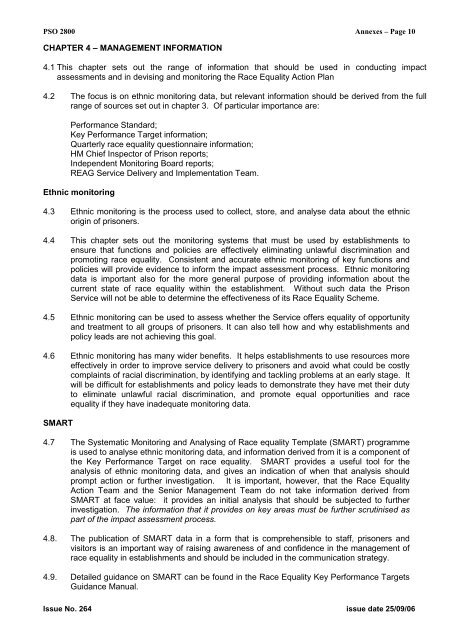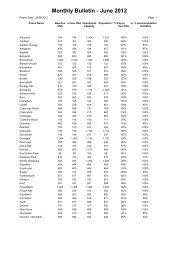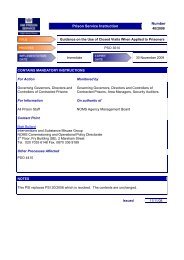PSO 2800 - Inside Time
PSO 2800 - Inside Time
PSO 2800 - Inside Time
- No tags were found...
Create successful ePaper yourself
Turn your PDF publications into a flip-book with our unique Google optimized e-Paper software.
<strong>PSO</strong> <strong>2800</strong> Annexes – Page 10CHAPTER 4 – MANAGEMENT INFORMATION4.1 This chapter sets out the range of information that should be used in conducting impactassessments and in devising and monitoring the Race Equality Action Plan4.2 The focus is on ethnic monitoring data, but relevant information should be derived from the fullrange of sources set out in chapter 3. Of particular importance are:Performance Standard;Key Performance Target information;Quarterly race equality questionnaire information;HM Chief Inspector of Prison reports;Independent Monitoring Board reports;REAG Service Delivery and Implementation Team.Ethnic monitoring4.3 Ethnic monitoring is the process used to collect, store, and analyse data about the ethnicorigin of prisoners.4.4 This chapter sets out the monitoring systems that must be used by establishments toensure that functions and policies are effectively eliminating unlawful discrimination andpromoting race equality. Consistent and accurate ethnic monitoring of key functions andpolicies will provide evidence to inform the impact assessment process. Ethnic monitoringdata is important also for the more general purpose of providing information about thecurrent state of race equality within the establishment. Without such data the PrisonService will not be able to determine the effectiveness of its Race Equality Scheme.4.5 Ethnic monitoring can be used to assess whether the Service offers equality of opportunityand treatment to all groups of prisoners. It can also tell how and why establishments andpolicy leads are not achieving this goal.4.6 Ethnic monitoring has many wider benefits. It helps establishments to use resources moreeffectively in order to improve service delivery to prisoners and avoid what could be costlycomplaints of racial discrimination, by identifying and tackling problems at an early stage. Itwill be difficult for establishments and policy leads to demonstrate they have met their dutyto eliminate unlawful racial discrimination, and promote equal opportunities and raceequality if they have inadequate monitoring data.SMART4.7 The Systematic Monitoring and Analysing of Race equality Template (SMART) programmeis used to analyse ethnic monitoring data, and information derived from it is a component ofthe Key Performance Target on race equality. SMART provides a useful tool for theanalysis of ethnic monitoring data, and gives an indication of when that analysis shouldprompt action or further investigation. It is important, however, that the Race EqualityAction Team and the Senior Management Team do not take information derived fromSMART at face value: it provides an initial analysis that should be subjected to furtherinvestigation. The information that it provides on key areas must be further scrutinised aspart of the impact assessment process.4.8. The publication of SMART data in a form that is comprehensible to staff, prisoners andvisitors is an important way of raising awareness of and confidence in the management ofrace equality in establishments and should be included in the communication strategy.4.9. Detailed guidance on SMART can be found in the Race Equality Key Performance TargetsGuidance Manual.Issue No. 264 issue date 25/09/06
















